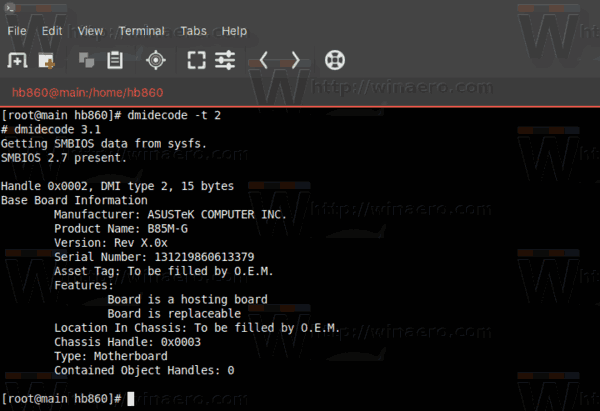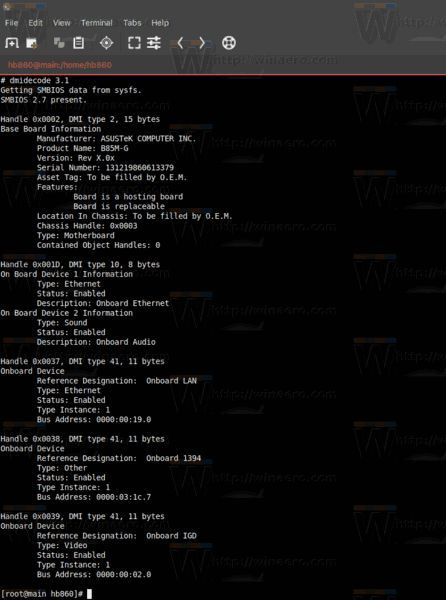In Windows, you can see information about the motherboard installed in your PC using various GUI tools. In Linux, there are no such tools installed out of the box. While you can install some of them to get motherboard information, there is a single console command you can issue and get your motherboard model and other details instantly.
Advertisеment
There is a special console tool dmidecode which utilizes sysfs to provide information about your motherboard. Here is a brief description of the tool taken from its man page.
dmidecode is a tool for dumping a computer's DMI (some say SMBIOS) table contents in a human-readable format. This table contains a description of the system's hardware components, as well as other useful pieces of information such as serial numbers and BIOS revision. Thanks to this table, you can retrieve this information without having to probe for the actual hardware.
While this is a good point in terms of report speed and safeness, this also makes the presented information possibly unreliable. The DMI table doesn't only describe what the system is currently made of, it also can report the possible evolutions (such as the fastest supported CPU or the maximal amount of memory supported).
SMBIOS stands for System Management BIOS, while DMI stands for Desktop Management Interface. Both standards are tightly related and developed by the DMTF (Desktop Management Task Force).
As you run it, dmidecode will try to locate the DMI table. It will first try to read the DMI table from sysfs, and next try reading directly from memory if sysfs access failed. If dmidecode succeeds in locating a valid DMI table, it will then parse this table and display a list of records like this one:
Handle 0x0002, DMI type 2, 8 bytes.
Base Board Information Manufacturer: Intel
Product Name: C440GX+
Version: 727281-001
Serial Number: INCY92700942Each record has:
A handle. This is a unique identifier, which allows records to reference each other. For example, processor records usually reference cache memory records using their handles.
A type. The SMBIOS specification defines different types of elements a computer can be made of. In this example, the type is 2, which means that the record contains "Base Board Information".
A size. Each record has a 4-byte header (2 for the handle, 1 for the type, 1 for the size), the rest is used by the record data. This value doesn't take text strings into account (these are placed at the end of the record), so the actual length of the record may be (and is often) greater than the displayed value.
Decoded values. The information presented of course depends on the type of record. Here, we learn about the board's manufacturer, model, version and serial number.
To find the motherboard model in Linux, do the following.
- Open a root terminal.
- Type the following command to get the brief information about your motherboard:
dmidecode -t 2
The output will be like this:

- To get more details about your motherboard information, type or copy-paste the following command as root:
dmidecode -t baseboard
See the following screenshot:

The -t argument filters the output by the specified DMI type. 2 means 'Baseboard'.
When you are using the 'baseboard' option for the -t argument, it uses a combination of DMI types (as SMBIOS specification defines), so you see more details.
Type man dmidecode to learn more about its command line argument.
That's it.
Support us
Winaero greatly relies on your support. You can help the site keep bringing you interesting and useful content and software by using these options:

send me updates—-**NICE!!–thanks
You said:
** In Windows, you can see information about the motherboard installed in your PC using various GUI tools. In Linux, there are no such tools installed out of the box. **
Bullsh8t. Type dmesg -H. Every Linux computer will give you breathtakingly detailed hardware information “out of the box” with that command.
I’m sorry to disappoint you, but Linux is not a toy like Windows is.
Lawrence
dmesg is not a GUI tool.
thanks
thanks